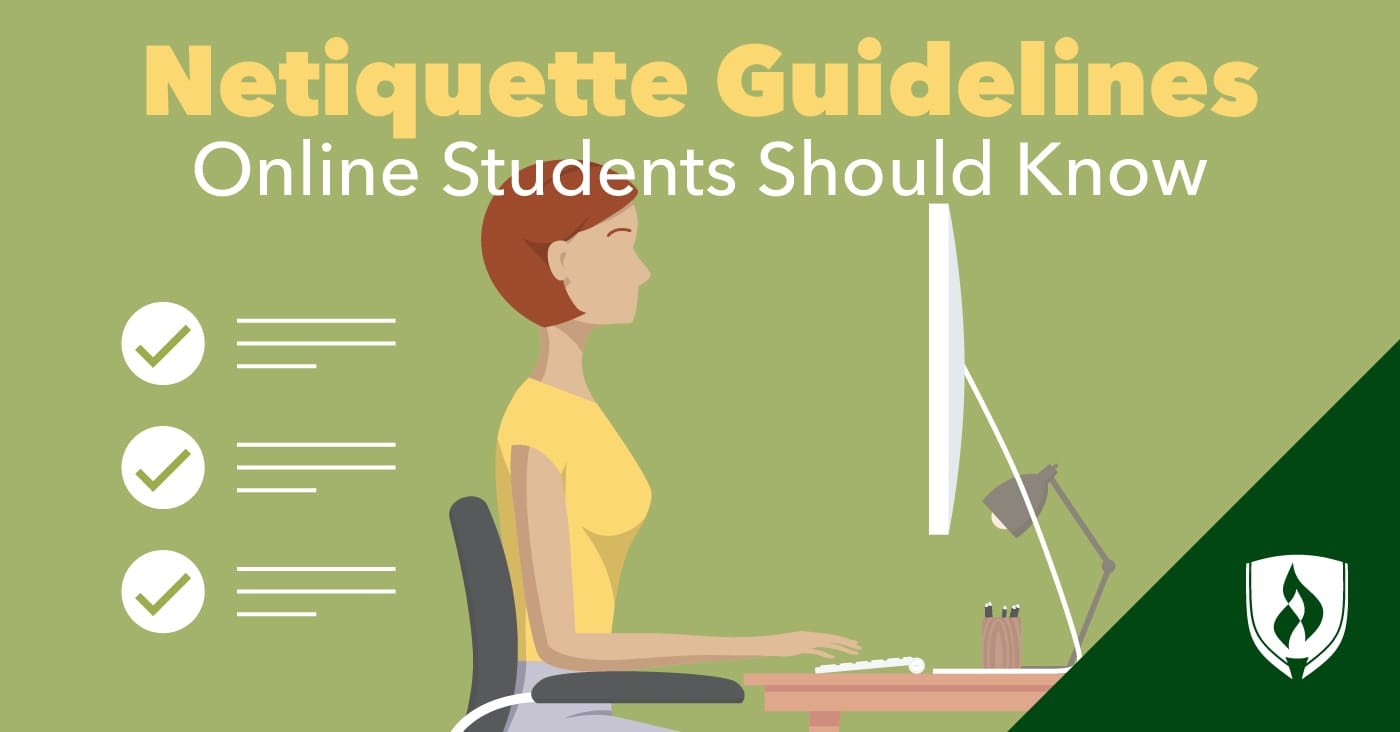Proper etiquette is nothing new for most people. You grew up with your parents constantly telling you to mind your manners. But in a digital age where the unwritten online “rules” are constantly changing, proper “netiquette” may seem a bit mystifying. Add in the atmosphere of an online classroom, and suddenly the proper netiquette guidelines don’t seem as easy as a simple “please” and “thank you.”

As you might have guessed, netiquette is essentially rules and norms for interacting with others on the internet in a considerate, respectful way. We enlisted several experts to set some guidelines to make sure your online manners are up to par.
10 Netiquette guidelines every online student needs to know
Learn how to be on your best behavior in an online classroom with 10 netiquette guidelines every online student needs to know.
1. NO YELLING, PLEASE
There’s a time and a place for everything—BUT IN MOST SITUATIONS TYPING IN ALL CAPS IS INAPPROPRIATE. Most readers tend to perceive it as shouting and will have a hard time taking what you say seriously, no matter how intelligent your response may be. If you have vision issues, there are ways to adjust how text displays so you can still see without coming across as angry or upset.
This is true for both posting to online course walls or discussions—like those found in online programs at Rasmussen University—and with personal email communications with your professors and advisors. Using appropriate capitalization and focusing on your tone when writing will give your virtual communication a boost.
2. Sarcasm can (and will) backfire
Sarcasm has been the source of plenty of misguided arguments online, as it can be incredibly difficult to understand the commenter’s intent. What may seem like an obvious joke to you could come across as off-putting or rude to those who don’t know you personally. As a rule of thumb, it’s best to avoid sarcasm altogether in an online classroom. Instead, lean toward being polite and direct in the way you communicate to avoid these issues.
3. Don’t abuse the chat box
Chat boxes are incorporated into many online classes as a place for students to share ideas and ask questions related to the lesson. It can be a helpful resource or a major distraction—it all depends on how well students know their classroom netiquette.
“Rather than asking relevant questions or giving clear answers, students might use the chat box to ask questions irrelevant to the discussion, or to talk about an unrelated topic,” says Erin Lynch, senior educator at Test Innovators. The class chat box isn’t an instant messenger like you’d use with friends. Treat it like the learning tool it’s meant to be, and try not to distract your classmates with off-topic discussions. Use it instead to ask relevant questions and participate in class when the professor asks.
4. Attempt to find your own answer
If you’re confused or stuck on an assignment, your first instinct may be to immediately ask your instructor a question. But before you ask, take the time to try to figure it out on your own.
For questions related to class structure, such as due dates or policies, refer to your syllabus and course FAQ. Attempt to find the answers to any other questions on your own using a search engine. If your questions remain unanswered after a bit of effort, feel free to bring them up with your instructor.
At Rasmussen University, you’ll also have lots of support outside of the classroom too including 24/7 technology support, student advisors, and library services to help you find answers about your classwork, technology access, or curriculum plan.
5. Stop ... grammar time!
Always make an effort to use proper punctuation, spelling and grammar. Trying to decipher a string of misspelled words with erratic punctuation frustrates the reader and distracts from the point of your message. While this is something you should pay attention for all your virtual communication, it’s especially important for the papers and assignments you’ll turn in. If grammar and spelling are generally a weakness for you, don’t get discouraged. At Rasmussen University, you’ll have access to the library’s writing lab where you can submit a paper to receive feedback on both your grammar and your writing overall.
On the flip side of this, it’s important to be reasonable about others’ grammar mistakes. Nobody likes the grammar police, so scolding a classmate because they used “your” instead of “you’re” isn’t practicing proper netiquette.
6. Set a respectful tone
“An increasingly common netiquette faux pas is treating e-correspondence with faculty and staff as an ongoing chat among friends,” says Alexey Timbul, online professor at the Academy of Art University.
Every day may feel like casual Friday in an online classroom where you don’t see anyone in person, but a certain level of formality is still expected in your communication with instructors. In addition to proper punctuation and spelling, it’s good netiquette to use respectful greetings and signatures, full sentences and even the same old “please” and “thank you” you use in real life.
7. Submit files the right way
You won’t be printing assignments and handing to them to your teacher in person, so knowing how to properly submit your work online is key to your success as an online student. Online course instructors often establish ground rules for file assignment submissions, like naming conventions that help them keep things organized or acceptable file formats. Ignoring these instructions is a common example of bad netiquette.
“Receiving work that does not adhere to the file format and naming protocol means a student is not paying attention,” says Timbul. If you don’t follow instructions, you’re taking the risk that your instructor won’t be able to find or open your assignment. Save yourself and your instructor a headache and read their instructions carefully before submitting.
8. Read first
Take some time to read through each of the previous discussion post responses before writing your own response. If the original post asked a specific question, there’s a good chance someone has already answered it. Submitting an answer that is eerily similar to a classmate’s indicates to the instructor that you haven’t paid attention to the conversation thus far.
Remember, discussions can move fairly quickly so it’s important to absorb all of the information before crafting your reply. Building upon a classmate’s thought or attempting to add something new to the conversation will show your instructor you’ve been paying attention.
9. Think before you type
A passing comment spoken in class can be forgotten a few minutes later, but what you share in an online classroom is part of a permanent digital record. “Whether or not privacy settings are in place, the internet has a tendency to house things forever, and what you say privately can easily become public,” advises etiquette expert Devoreaux Walton.
Not only is it good practice to be guarded when it comes to personal information, you always want to be just as respectful toward others as you would be if you were sitting in the same room together. Zink says a good rule of thumb to follow is if you’re comfortable standing up in front of a classroom and saying your message, then it’s most likely okay to share.
10. Be kind and professional
Online communication comes with a level of anonymity that doesn’t exist when you’re talking to someone face-to-face. Sometimes this leads people to behave rudely when they disagree with one another. Online students probably don’t have the complete anonymity that comes with using a screen name, but you could still fall prey to treating someone poorly because of the distance between screens. Make a point to be kind and respectful in your comments—even if you disagree with someone.
“At the core, all of these mistakes come down to forgetting that an online classroom is still a classroom,” Lynch says. “Good netiquette means conducting yourself in an online class with the same respect, politeness and professionalism that you would exhibit in a real-life classroom.”
Plus, practicing professional communication skills while you’re in school will serve you will in the workplace as well—whether you end up working remotely or not. Rasmussen University places a special emphasis on practicing transferable skills that you can take from the classroom to the workplace.
Practice makes perfect
You’ve just completed your crash course in netiquette guidelines, so go out there and post like the well-mannered student you are! If you’re looking to get started in an online program, check out the fully-online degree options at Rasmussen University.
EDITOR’S NOTE: This article was originally published in 2014. It has since been updated.




